Why hello there and thanks for joining me once again on my adventures of the capital! Today’s walk really is a true river and city stroll which will take in some of the most well-known sights London has to offer. I’ll begin in Covent Garden then move onto Victoria Embankment Gardens go along Embankment to explore Temple and then the bridges of Blackfriars. My journey will then see me go past the Tate Modern, Millennium Bridge and end at Southwark Bridge! It’s a long walk with plenty to see, so we best get going!

Located near the West End between Charing Cross Road and Drury Lane, Covent Garden is a bustling shopping and tourist site which dates back to the Saxon era. Back in mid-Saxon times, the area was a thriving trading settlement which was 60 hectares (148 acres) in size.


The trading part within Covent Garden was established along the Thames near The Strand and stretched as far back as Short’s Gardens near Covent Garden. By the late Saxon period and with the threat of Viking raids, the trading settlement moved leaving the area derelict and was turned into farmland.
Covent Garden derives its name (‘Convent Garden’) from the presence there in the Middle Ages of a garden belonging to Westminster Abbey. In the 16th century the land was acquired by Henry VII and granted to John Russell who was the 1st Earl of Bedford. The land would be under the Bedford family name up until 1918.

The recognisable Piazza within Covent Garden was laid out in 1631 by Inigo Jones with the inspiration for it coming from the piazza’s of Italy which Jones had extensive knowledge of. The streets of Covent Garden have historical significance behind them with King Street, Charles Street and Henrietta Street named in honour of Charles I and the Queen Henrietta Maria. Catherine Street is named after the consort of Charles II, with Bedford Street, Russell Street, Southampton Street and Tavistock Street deriving their names from the Russell Family.

One of the distinctive features in Covent Garden on the west side of the Piazza is the St. Paul’s Church which was also designed by Inigo Jones as part of a commission from the 4th Earl of Bedford in 1631. The parish church has significant links to the theatre community which has resulted in it gaining the nickname of the ‘actors’ church’. The church was completed in 1633 and was the first new church in London since the Reformation when the Church of England broke away from the authority of the Pope and the Roman Catholic Church.


One of established aspects within the market was traders selling fruit and vegetables with the Earl of Bedford recognising the potential of this, which meant as a result he obtained a right to hold a market there. Furthermore, one of the main features of Covent Garden today are the shows which go on there, something which dates back to the 17th Century.

Into the 18th Century and with the aristocracy moving to more fashionable areas such as Soho and Mayfair, Covent Garden attracted many artists, journalists and writers who would regularly use the coffee shops and taverns in the area.
The Covent Garden Theatre, now termed the Royal Opera House was built by John Rich and opened in 1733. In 1786 the renowned composer Handel conducted his ‘Messiah’ within it, although in 1808 the entire area was gutted due to a fire. It would be reconstructed by Sir Thomas Smirke within a year, but in 1856 that too was destroyed by a fire! E.M. Barry’s Italian Opera House (The Royal Opera House) would replace it on the same site.
The 19th Century saw the reconstruction of the flower market, with the fruit and vegetable market being relocated to Nine Elms in Vauxhall in 1966. In the 1970s the land was acquired by the Greater London council and the Department of the Environment. The central Piazza has since been redeveloped into a mixture of restaurants and cafe’s, with commercial shops and stalls.
The market we see today really is something to behold and you can see why it attracts millions of tourists a year, especially around Christmas with the breathtaking festive decorations which lighten up the area. If you want to get into the Christmas spirit, or act like a tourist for the day, Covent Garden is certainly the place to be with plenty of sights to snap!




One of the most notable sights at Christmas is the famous tree within the Piazza, considerably bigger than most of our trees we’ll have!
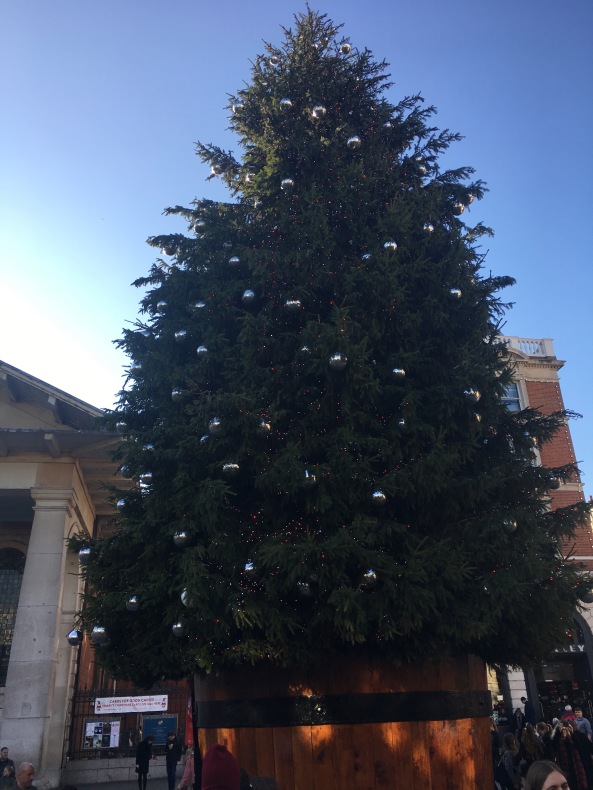
There is one final feature of Covent Garden which many walk past and visit every year, and that’s the London Transport Museum which is right in the corner of the area. Opened in 1980 the museum helps to showcase the transport heritage of the capital with a collection of old tubes, buses, trams and trains as well as plenty of memorabilia, and an amazing shop!

I’m now going to leave Covent Garden and make my way to the next stop on my walk, Victoria Embankment Gardens.


Victoria Embankment Gardens are a series of gardens on the north side of the River Thames between Westminster Bridge and Blackfriars Bridge. The gardens were designed by Sir Joseph Bazelgette and opened in 1865. My walk sees me firstly visit the gardens located near The Strand. The area really is a delightful place to sit and relax whilst you overlook the River Thames in the background and are full of flowers, trees, plants and fountains!


At the moment we’re well into Autumn and heading towards Winter, but during the Spring months, the gardens are a hub for beautiful tulips which have an array of colours like a rainbow!

I’ll now leave Victoria Embankment Gardens near the Strand and take a rather wonderful stroll along the Thames where you get to see many of the capital’s best landmarks.

You certainly won’t be struggling for the sights of London, with Waterloo Bridge and The London Eye on display, and if you want to find out more about them, check out one of my previous walks!

A walk along the Thames takes you to the Victoria Embankment Gardens section in Temple. One thing I love about the Embankment area are that the trees are all perfectly spaced out with the branches draped over the edge of the walls, there’s something really pleasing and pretty about this. The long stretch as far as the eye can see is full of trees and runners, with the busy road on the left and the peaceful flowing of the Thames on the right.

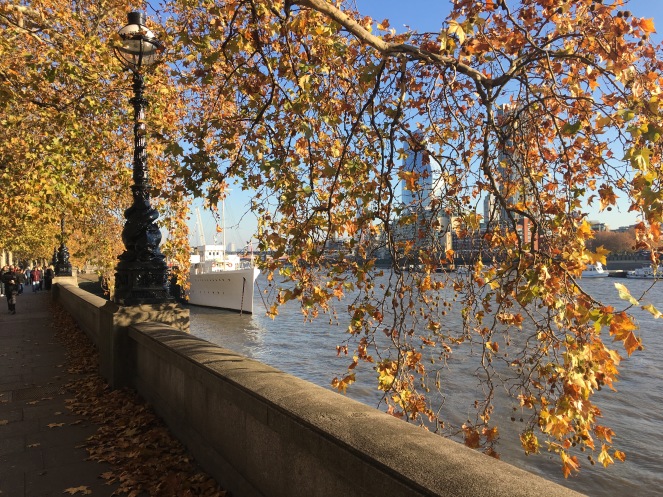
The Victoria Embankment Gardens in Temple are just as tranquil and picturesque as the one near the Strand.
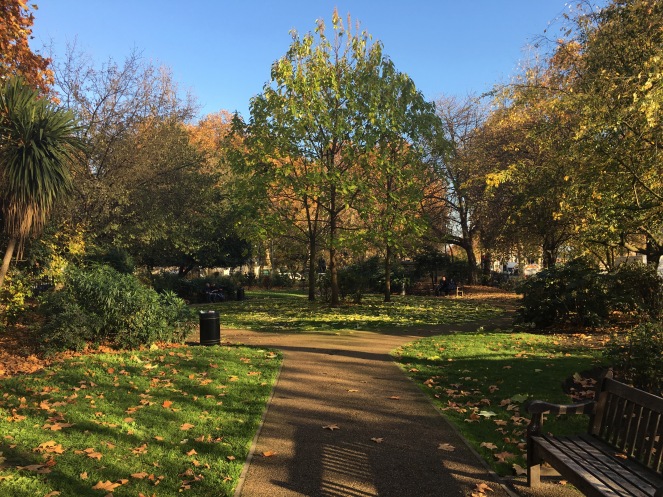

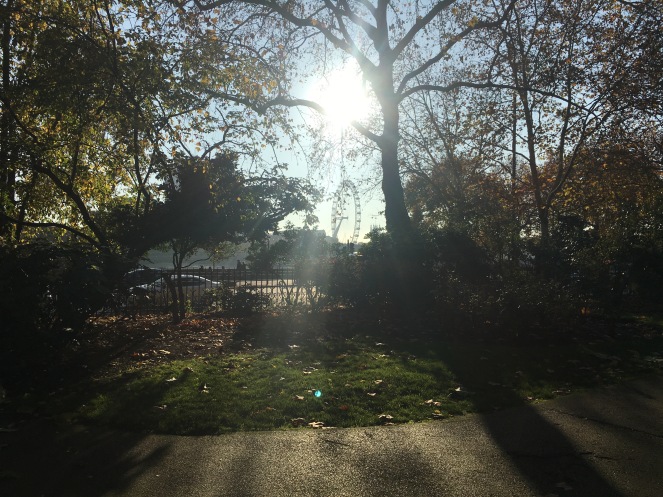
On the end of the gardens sits the historically grand and architectural gem Two Temple House which is a late Victorian mansion built by William Waldorf Astor and opened in 1895. Designed by neo-Gothic architect John Loughborough Pearson, the house hosts art exhibitions as well as being a venue to hire.
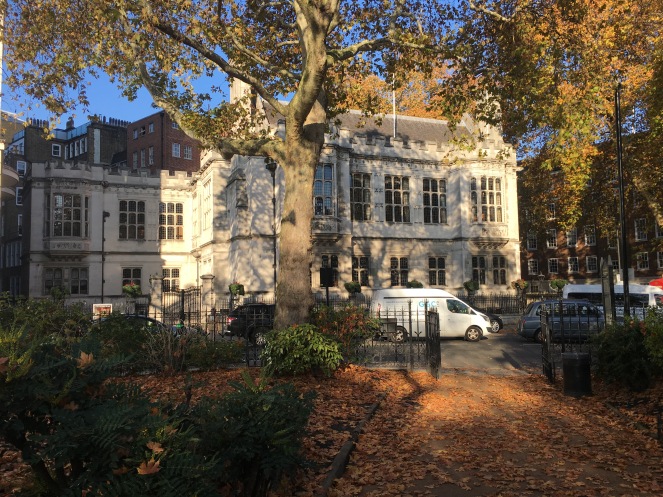


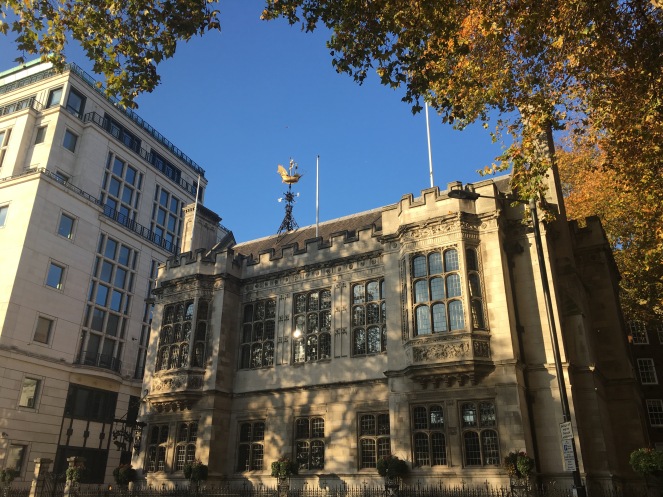
Walking past the house you find many cute little alleyways and streets as you go through Temple which is known for its law practices, although on a weekend it’s eerily quiet without all the lawyers and solicitors present!


Going through Temple along the Strand takes you to The Royal Courts of Justice which is the High Court and Court of Appeal of England and Wales. Designed by George Edmund Street who unfortunately died before they were completed, the Victorian Gothic style building was opened by Queen Victoria in 1882 and is one of the largest courts in Europe.
No matter whether a building hosts law or art or events, the landmarks in London are never understated or dull, but have such character and architectural brilliance about them, something which was evident when they were all built. Whereas the newer buildings of London are more glass based, the older ones still have a marvellous place in the city and are one of many reasons we all fall in love with the capital.



I’ll take a walk away from Temple and back onto Embankment as I head towards my next stop on today’s walk, Blackfriars!

The walk along Embankment to Blackfriars gives you a glistening autumnal feel with the golden leaves along the pathway and the sun shining onto the trees.

Just before Blackfriars Bridge you find this cute little pub called The Black Friar which is a Grade II listed public house. Built in 1875 on the former site of a medieval Dominican friary, it was redesigned in 1905 by architect Herbert Fuller-Clarke, with most of the internal decoration done by sculptors Frederick T. Callcott and Henry Poole. The pub faced being demolished during the 1960s until it was saved by a campaign spearheaded by poet Sir John Betjeman. It really is a true hidden gem of the capital and perhaps one of the smallest pubs you’ll come across but with so much character and illustrates the historical side of London, and why pubs are such an integral part of the identity of our great city.
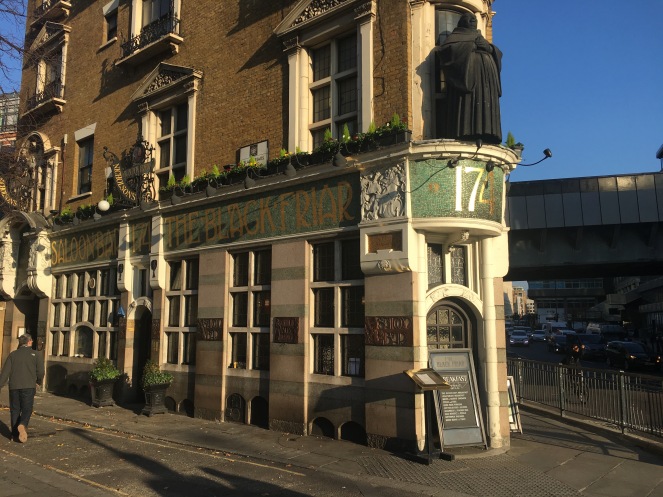

A walk from the Black Friar takes me to one of London’s many bridges, Blackfriars Bridge! Opened in 1869 the bridge was designed by Joseph Cubitt and is 923 feet long and with a width of 105 feet. In 1972 the bridge was granted Grade II listed status!

Standing on the bridge on the one side you get a stunning view of the London Eye and on the other you can see St Paul’s, The Walkie Talkie, The Tate, The Shard and Blackfriars Railway Bridge.



There are two structures that have the honour of being called Blackfriars Railway Bridge, the first was opened in 1864 and designed by Joseph Cubitt too for the London, Chatham and Dover Railway. The abutments of this are still present today on the end of the bridge’s old structure. In 1924 with the formation of Southern Railway, the inter-city and continental services were transferred to Waterloo and St Paul’s which resulted in the bridge gradually declining. It would become too weak to support modern trains and as a result was removed in 1985, though pillars of it can still be seen and have Grade II listed status.
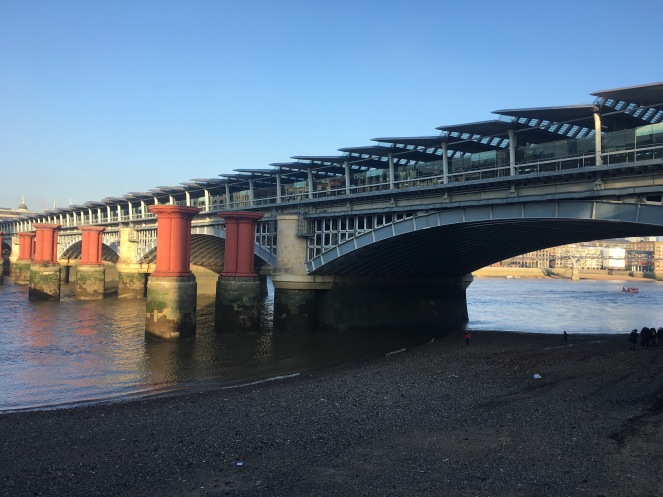
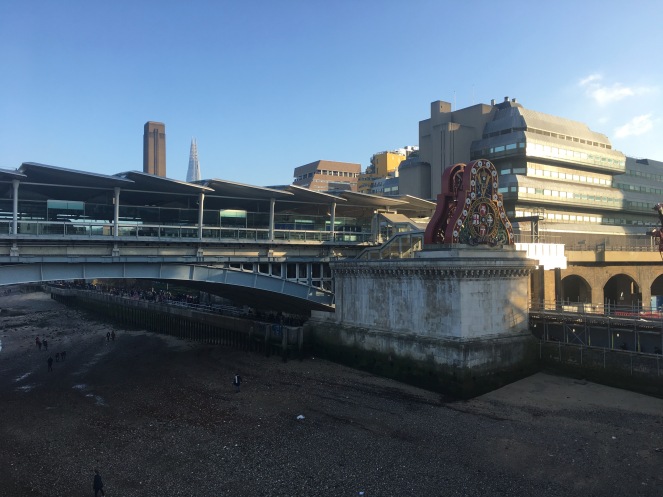

The second bridge, originally called St Paul’s Railway Bridge, was designed by John Wolfe-Barry and Henry Marc Brunel, and opened in 1886. In 1937 St Paul’s railway station was renamed Blackfriars with the bridge changing its name also. Blackfriars Bridge railway station opened in 1864 before closing to passengers in 1885 following the opening of what today is the main Blackfriars Station. Blackfriars Bridge railway station would continue as a goods stop up until 1964.
The current Blackfriars Railway Bridge has 4,400 roof-mounted solar panels which makes up 50% of the power for the station which is located on the bridge for Thameslink trains.


On the day that I did this lovely walk, the tide was out so this gave me a unique opportunity to walk along the Thames and under the bridges to see some of the capital’s favourite landmarks from a different perspective.


My walk takes me to another one of London’s most recognisable landmarks, the Tate Modern which is Britain’s national gallery of international modern art and part of the Tate Group (Tate Britain, Tate Liverpool, Tate St Ives, Tate Online). The gallery was opened by the Queen in 2000 with it holding collections of British art from 1900 to the present day.


The Tate Modern is housed in the former Bankside Power Station which was designed by Sir Giles Gilbert Scott, the same architect who designed Battersea Power Station and you can see the similarities! The structure was built in two stages between 1947 and 1963, with the power station closing in 1981.
The building was at risk of being demolished until numerous campaigns helped to save it, before the Tate announced plans to turn it into a gallery in 1994. In that same year a competition was run to find the architects to design the gallery, and in 1995 Jacques Herzog and Pierre de Meurn of Herzog & de Meuron were chosen. The £134 million development took five years to undertake and it is quite remarkable that it has only been open since 2000 as I just can’t imagine it not being a gallery!

Right outside the Tate Modern you find another landmark which has been in the capital since the turn of the 21st Century, the Millennium Bridge. Opened in June 2000, the bridge is 325 metres in length and was designed by Arup (engineers), Foster and Partners (architects) and Sir Anthony Caro (sculptor).
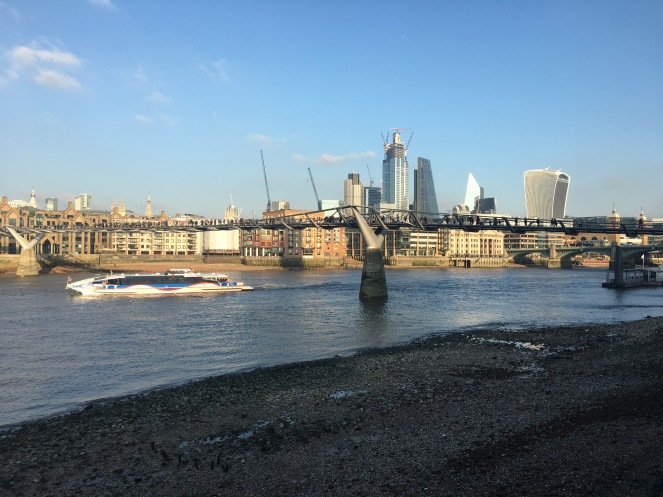
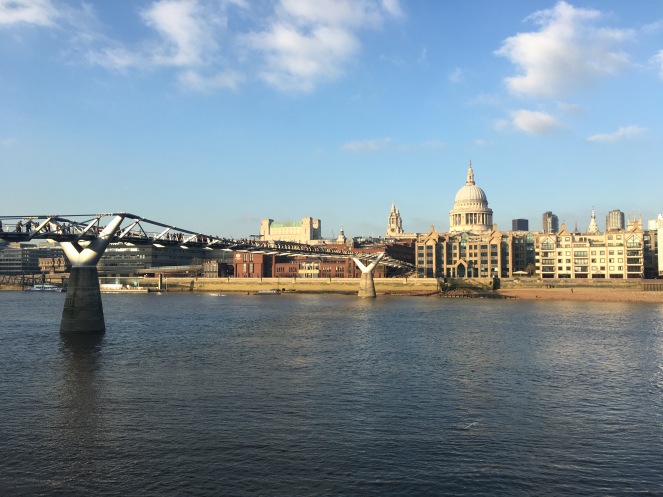
The bridge was the first to be built over the Thames for 100 years with it taking two years to construct at a cost of £18.2 million, which was paid for by the Millennium Commission and the London Bridge Trust.
One unique aspect of the Millennium Bridge is that it has had two openings, first in 2000 and then again in 2002. On its opening day the bridge had 80,000 people walk across it and 2,000 on it at any one time. However, on the southern and central part of the bridge people felt it swaying and as a result the bridge was closed and given the nickname the ‘Wobbly Bridge’. The bridge lasted only one day and it wasn’t until February 2002 that it reopened to the public!

Once again you get a stunning view across the Thames, with the newly built One Blackfriars building on one side, and on the other Southwark Bridge, St Paul’s, the Walkie Talkie and the Cheesegrater. It is always amazing how even though all the bridges are along the same path of the river, they provide their own distinctive view of the capital’s landmarks.



A photo which many Instagrammers love to take is of St Paul’s front view on the end of the bridge, and you can see why it’s so popular!

My journey will now end at Southwark Bridge which was originally built in 1819 by Sir William Arrol & Co with the design from Ernest George and Basil Mott. Known as Queen Street Bridge, it was redesigned by John Rennie and reopened in 1921 with the new name Southwark Bridge given to it.


Well thank you for joining me on my walk where I’ve explored the very best of London’s recognisable sights from Covent Garden to the Tate Modern, and uncovered the wonderful stories and history of four of the capital’s bridges!
In the meantime you can catch me on Twitter and Instagram and don’t forget to sign up to my blog too! Also why not have a read of my other walks which explore all over London, from north to south, to west to east via central, there’s something there for you! 🙂
Sources: (not the food sauces)
All photos taken by London Wlogger © Copyright 2018
The Covent Garden Trust: History of Covent Garden
The London Transport Museum: Information about The London Transport Museum
Westminster City Council: History of Victoria Embankment Gardens
Two Temple House: History of Two Temple House
Royal Courts of Justice: History of the Royal Courts of Justice
The Black Friar: History of the Black Friar
Blackfriars Bridges: History of Blackfriars Bridges
The Tate Modern: History of the Tate Modern
The Millennium Bridge: History of the Millennium Bridge

We’ve done almost all of these areas, but not all in one walk. We especially love walking along the Embankment and watching all the traffic on the river.
LikeLiked by 1 person
It’s such an iconic part of London to explore and there’s always something to see and take a photo of! 😃
LikeLiked by 1 person
A lovely walk. London is such a lovely place to walk around. So theatrical.
LikeLiked by 1 person
It’s so very grand and the buildings all have such character and presence! 😃
LikeLiked by 1 person
you had great weather for this walk!
LikeLiked by 1 person
It was so beautiful, perfect autumnal/winter weather, quite the contrast to the recent rainy stuff we’e had! I always do my walks in the sun, makes for better photos and is more pleasant!
LikeLike
Having had your detailed info would have been lovely when we walked this route in the spring of 2017. I had been curious about the Blackfriars railway bridge pillars.
LikeLiked by 1 person
Hopefully you can do the walk again soon! Glad you’ve got a bit of insight into the areas ☺️
LikeLike
A walk that can be done over and over again .. always something new to see.
LikeLiked by 1 person
Couldn’t agree more, you’ll always spot something new, or a landmark or piece of history that you’ve not discovered before, so much to see!
LikeLiked by 1 person
I love your blog! I spent 10 years in London and it’s my favourite place! Fantastic photos too.
LikeLiked by 1 person
Aww thank you so much, that’s amazing to hear! Hope you enjoy all of my other previous and future walks 🙂
LikeLike